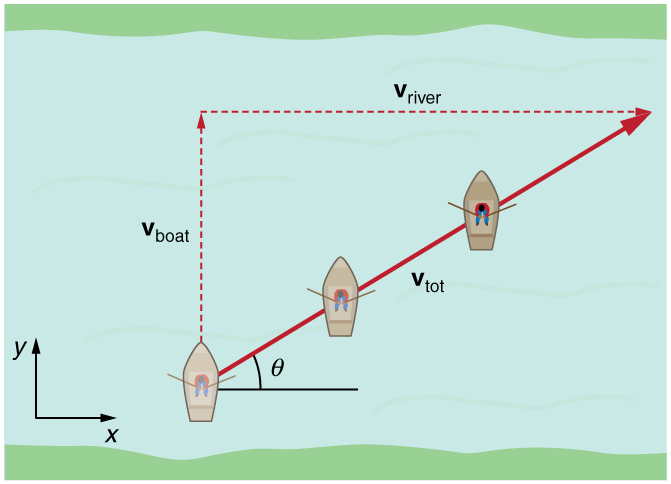Physics problem, need help.
The entrance to a harbour is a channel of length a which runs between two sandbanks a distance b apart. The banks and the channel can be assumed to be rectangular. On this particular day, there is a current of constant speed v flowing from one sandbank to the other. A yacht travelling at a constant speed relative to the water of u wants to enter the harbour.
Find the least value of u needed for the yacht to safely enter the harbour.
Someone please help me solve this and/or provide an answer, I'm struggling.
Find the least value of u needed for the yacht to safely enter the harbour.
Someone please help me solve this and/or provide an answer, I'm struggling.
Original post by student273
The entrance to a harbour is a channel of length a which runs between two sandbanks a distance b apart. The banks and the channel can be assumed to be rectangular. On this particular day, there is a current of constant speed v flowing from one sandbank to the other. A yacht travelling at a constant speed relative to the water of u wants to enter the harbour.
Find the least value of u needed for the yacht to safely enter the harbour.
Someone please help me solve this and/or provide an answer, I'm struggling.
Find the least value of u needed for the yacht to safely enter the harbour.
Someone please help me solve this and/or provide an answer, I'm struggling.
This is the classic riverboat vector problem with the usual flow of the river and boat direction transposed:

The x direction is also the length of the channel.
The y direction is the channel width and river flow direction.
The boat therefore has a y velocity component given by the river current.
So the problem is to derive an expression for the speed and direction of the boat relative to the river flow, in order to transit the length of the channel in the time it takes to cross the channel.
HINT: redraw the above diagram to comply with the labels defined by the question you posted.
(edited 6 years ago)
Original post by uberteknik
This is the classic riverboat vector problem with the usual flow of the river and boat direction transposed:

The x direction is also the length of the channel.
The y direction is the channel width and river flow direction.
The boat therefore has a y velocity component given by the river current.
So the problem is to derive an expression for the speed and direction of the boat relative to the river flow, in order to transit the length of the channel in the time it takes to cross the channel.
HINT: redraw the above diagram to comply with the labels defined by the question you posted.

The x direction is also the length of the channel.
The y direction is the channel width and river flow direction.
The boat therefore has a y velocity component given by the river current.
So the problem is to derive an expression for the speed and direction of the boat relative to the river flow, in order to transit the length of the channel in the time it takes to cross the channel.
HINT: redraw the above diagram to comply with the labels defined by the question you posted.
Thanks, but I'm still really confused as to how I give my answer (U) in terms of V
Original post by student273
Thanks, but I'm still really confused as to how I give my answer (U) in terms of V
The boat will drift at the same velocity as the current Vms-1 between the sandbanks. The distance between the sandbanks is given as (b) metres and takes time tdrift seconds to cross from one side to the other.
rearranging for tdrift:
................eq 1
For safe passage, the boat must traverse the length of the channel (a) metres before the time tdrift elapses.
................eq 2
substituting eq 1
removing the subscripts and complying with the minimum time requirement:
(edited 6 years ago)
Original post by uberteknik
The boat will drift at the same velocity as the current Vms-1 between the sandbanks. The distance between the sandbanks is given as (b) metres and takes time tdrift seconds to cross from one side to the other.
rearranging for tdrift:
................eq 1
For safe passage, the boat must traverse the length of the channel (a) metres before the time tdrift elapses.
................eq 2
substituting eq 1
removing the subscripts and complying with the minimum time requirement:
rearranging for tdrift:
................eq 1
For safe passage, the boat must traverse the length of the channel (a) metres before the time tdrift elapses.
................eq 2
substituting eq 1
removing the subscripts and complying with the minimum time requirement:
Hi there, I completely understand the answer that you have given, but when I enter it apparently the boat is not necessarily travelling perpendicular to V therefore it cannot be U=av/b
Original post by student273
Hi there, I completely understand the answer that you have given, but when I enter it apparently the boat is not necessarily travelling perpendicular to V therefore it cannot be U=av/b
Working and diagram
I realise that this is quite some time after requested, but hopefully this is useful to others:
Starting from eq 2 from @uberteknik:
a can be expressed in terms of u as
a = ut / (cos(θ))
so u = (a * cos(θ))/t
Now, we can solve for cos(θ)
Answer
I realise that this is quite some time after requested, but hopefully this is useful to others:
Starting from eq 2 from @uberteknik:
a can be expressed in terms of u as
a = ut / (cos(θ))
so u = (a * cos(θ))/t
Now, we can solve for cos(θ)
•
cos(θ) = b / (b^2+a^2)^(1/2) eq 3 Where (b^2+a^2)^(1/2) is the minimum distance the boat must travel, so gives minimum u
•
Now if we substitute eq 3and eq 1 back into eq 2
•
We get:
•
u = ab*v / b*(b^2+a^2)^(1/2)
•
Which cancels to give:
•
u = av / (b^2+a^2)^(1/2)
•
Which Isaac Physics had told me is the right answer
Answer
(edited 4 months ago)
Quick Reply
Related discussions
- What are these a levels and their courses like?
- 4 weeks till paper 1 - how to improve at AQA physics?
- Tips for A*s?
- How do i improve physics problem solving?
- is it a good choice to take biology physics further maths without chem?
- Does further maths help with maths entrance exams?
- Any tips on how to study for the last year of a-levels?
- Entry requirements for Physics and Astrophysics degree
- Mental health nursing or Social care
- I crashed higher geography and im worried I wont pass
- Advice for getting A*s in A levels
- Wanting to study A levels as an adult - help!
- Studying mechanical engineering as an economic student
- GCSE Physics Study Group 2023-2024
- Preparing for the Oxford PAT- Maths
- A Level Coursework help
- Chemistry as a potential subject if I want to do computer science at uni?
- Is there a way to purely revise using past papers
- astrophysics/theoretical physics work experience for a y11
- applying for a pgce with gaps in my ug
Latest
Trending
Last reply 1 day ago
Edexcel A Level Politics Paper 1 (9PL0 01) - 21st May 2024 [Exam Chat]A-levels
10
Trending
Last reply 1 day ago
Edexcel A Level Politics Paper 1 (9PL0 01) - 21st May 2024 [Exam Chat]A-levels
10




